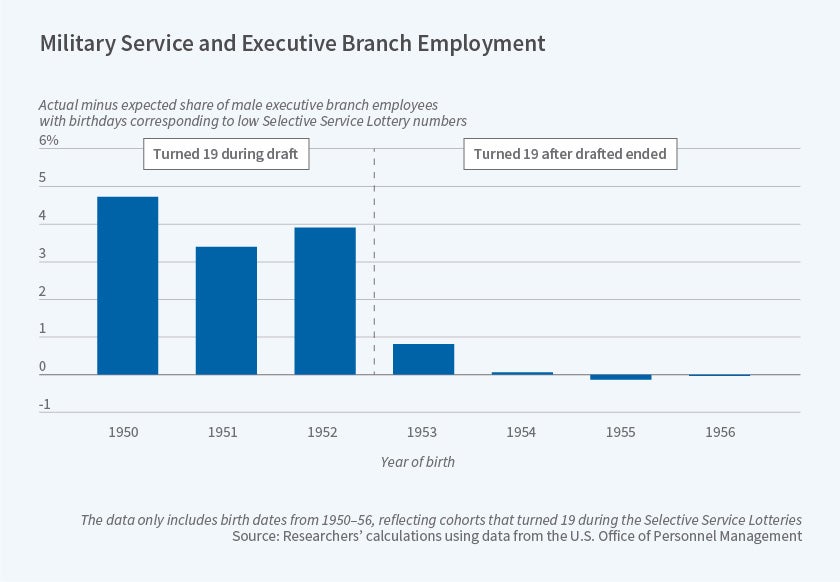Accounting for the High Percentage of Veterans in Public Service
Veterans constitute less than 10 percent of the U.S. population and more than 25 percent of federal government employees. Why?
Agencies at all levels of government generally give hiring preference to veterans of the armed services, and veterans represent a much higher share of the public-sector than the private-sector workforce. Is this differential attributable to hiring preferences, or might those who have served in the armed forces be predisposed to public service both in military and civilian capacities?
In Military Service and Public Sector Employment (NBER Working Paper No. 25859), Tim Johnson and Dalton Conley try to answer this question with respect to federal government employment. They find that men who were called — at random, based on their birthdays — for induction in the Vietnam Era Selective Service Lotteries were more likely to be employed by the executive branch of the federal government than their contemporaries with different birthdays who were not called for military service.
"These results," they write, "suggest that large-scale military mustering in times of war or the maintenance of large peacetime armies may have important long-term consequences on the composition of public and private sector labor markets."
The researchers studied the cohort of men born between 1950 and 1956. At age 19, they were subject to induction under the Vietnam Era Selective Service Lotteries, which randomly assigned draft numbers based on birthdates. Because the war wound down in the early '70s, only the first three years of the lottery led to actual call-ups.
The researchers also obtained data on all employees who worked for the executive branch of the federal government between June 2011 and March 2016, except for those in the Department of Defense and the U.S. Postal Service.
They found that birthdates associated with lottery numbers subject to call-up under the draft appeared disproportionately among the sampled federal workers in the 195052 birth cohort. Take, for example, the cohort born in 1950, when draft-eligible men with numbers up to 195 were most likely to be called for induction. Among the male workforce in the sample, 58 percent had birthdates associated with draft numbers subject to call-up. Had birthdates been uniformly distributed, only 53 percent (the ratio of 195, the draft cutoff, to 365 days) would have had these birthdates. Birthdates associated with lower draft numbers, meaning a higher probability of serving, were even more common in the federal employee database.
The researchers did not find any significant correlation between birthdates and federal employment among men in the 1953-56 birth cohort, who came of age after the military stopped inducting draftees. Such was the case, too, for all cohorts of women, who were not subject to the draft.
While the findings cast doubt on the view that veterans were highly represented in the federal workforce solely because they had a predisposition for both the military and civilian public sectors, it does not address other factors which may have influenced them to seek government jobs. For example, the researchers suggest that military service may have entitled some veterans to public sector jobs via preferential hiring, may have made them less competitive in the private sector because they missed out on private-sector work experience, or may have led them to develop a preference for working in the sort of organizational structures that are common to both military and civilian public bureaucracies.
— Steve Maas



